Steam Next Fest 2022 Demo Round-Up: Part Three
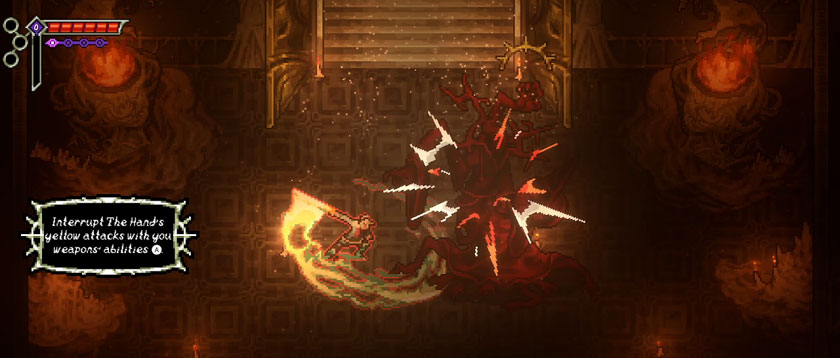
There Is No Light
I’m not sure the top-down hack-and-slash is quite for me. Perhaps if they took greater inspiration from The Legend of Zelda: A Link to the Past, but these games tend to go for something else (and, more often than not, it’s that “Souls-like” tag on Steam). I cannot say that There Is No Light is without promise, but there’s just something about it that failed to hook me.
The narrative establishes plenty of intrigue and curiosity, for sure. There’s something going on in this post-apocalyptic world where humans live underground, an oppressive theocracy enforces its rules, and children are gladly offered up to a faceless, hand-shaped creature revered as a god. A horrific creature resembling a reaper and plague doctor combined has saved our protagonist and given him powers to combat this supposed god, though this supernatural Industrial Metal mascot keeps his reasons closely guarded. Narratively, there’s definitely a hook.
The combat is what gives me pause. It seems the primary gimmick is to wait until an enemy is preparing an attack before striking out and interrupting them while they’re vulnerable. The nature of enemy mobs makes such a strategy more difficult to pull off than I’m sure is intended, and as such it’s easier to just dodge, strike once, dodge away again, strike once more, and so on. Guerilla-style hit-and-run tactics are far more effective than attempting the game’s far more risky mechanics. There’s also a meter you can build up to unleash an ability, potentially releasing a health gem that will heal the player once shattered. The problem is that, even with a successful interruption, foes rarely seem vulnerable enough to make filling up that bar and unleashing an ability possible without suffering even more damage. The timing is incredibly tight and the risk-reward balances far more on the “risk” category.
Or, perhaps, I’m just not very good at the game. The top down nature also made it difficult to determine where certain hit boxes were, whether they were based on the x-axis or y. Nonetheless, it was still an enjoyable enough experience with an intriguing narrative hook. It would not be the worst of the demos I’ve played, for certain. When surrounded by the promising games that had a far more enthusiastic response, however, it suffers the misfortune of seeming to lack the special ingredient each of those titles possessed.
Nonetheless, I may keep an eye out to see what shape the finished product is in. If another demo is released, I would likely check it out and see if they managed to tweak or polish the mechanics a bit further.
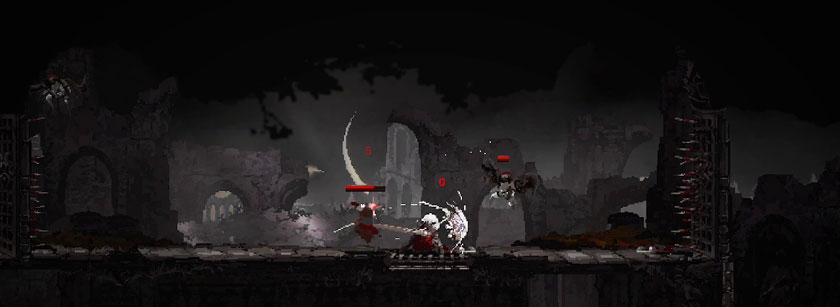
Moonscars
I imagine this game will no doubt get the “Souls-like” description attached to a lot of previews and reviews, but I think that will be an oversimplification of what Moonscars is doing. The inspiration is certainly there, but this game is one of those rare gems that tries to reinterpret the concepts presented to be their own thing. This is most clear in the healing mechanic, which draws from the same pool as your magic. Using powerful spells in combat means you’ll lose your reservoir of healing energy.
In addition, there’s also a “rogue-like” inspiration despite not being a rogue-like. After defeating enough monsters and foes the player will be able to select a boon to apply to their skills or stats. This could range from a healing bonus, to an “extra life” of sorts, to damage buffs, and so on. These are lost once the player chooses to rest at a “Dark Mirror”, the game’s equivalent to a bonfire. However, due to the game’s golem-focused narrative, each trip through the Dark Mirror also disposes of the “shell” you’ve been using, leaving a hostile and empty doppelganger husk behind. The player will have to face this doppelganger in combat, an intense fight where they possess the same abilities you had.
If I had any complaint, it is the lack of clarity in a successful parry being executed. The game informs you that performing a parry when an enemy’s eye flashes red will result in a counter-attack, and this often seems true. However, there are moments where damage is taken despite a successful counter-attack, indicating an unsuccessful parry. Are some attacks unparryable? Is it a matter of timing? Can you chain parries together due to the bum rush nature of some of these enemy attacks?
Despite these questions, I was surprised to find myself as enamored with Moonscars as I was. Like Signalis, I was caught off guard by the demo’s end, ready to keep going and play some more. I had seen the trailer during Steam Next Fest, but getting my hands on the title is what really left an impression on my mind. Had I only been so hyped for this rather than VergeWorld! Regardless of the ineffective nature of trailers and blitzing audiences with one pixel-art Metroidvania Souls-like after another, I look forward to the final release and have wishlisted the title with gusto. They say seeing is believing, but in the world of games, it’s all about playing, and playing Moonscars made all the difference.
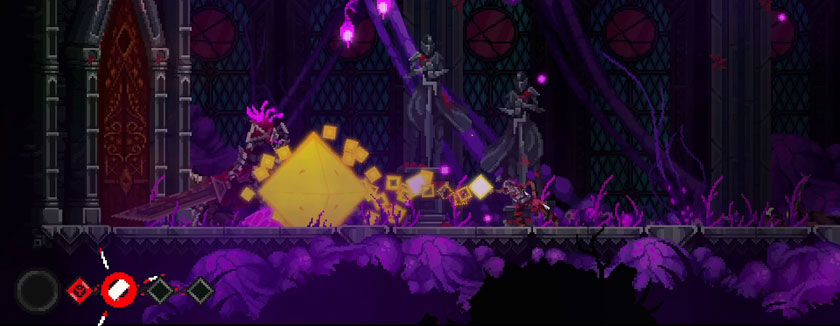
The Tarnishing of Juxtia
After five minutes with this demo I was ready to throw in the towel. “That’s it,” I thought to myself, “not only is it another Souls-like, but it’s the most derivative to boot”. Last February I had lamented the inability of Salt and Sanctuary to do anything interesting with the Souls-like genre, merely recreating the experience on a two-dimensional plane. The Tarnishing of Juxtia was accomplishing much the same task, delivering the familiar Dark Souls experience but as a pixelated side-scroller.
Thirty minutes later I was checking the time, eager to keep going but knowing I had to stop so I could meet up with a friend. By the time I returned home later that afternoon, I booted the demo back up and resumed my save. Despite being the most Souls-like title I played all Next Fest, it had some secret ingredient that drove me to play on.
Perhaps it was the platforming elements. While not as old-school and complex as what you’d get from Hollow Knight, it made traversal around the world a bit tricky; rickety platforms would crumble beneath the player while others would sport whirling buzzsaws circulating around their surface area. Maybe it was the placement of shortcuts and treasures across its map, rewarding exploration. It could also have been the emphasis on magic, a skill I typically neglect in role-playing games to focus more on melee action. Or perhaps it’s something far more simple: boss fights that consistently had me succeeding by the skin of my teeth, their tough timings and punishing damage leaving me satisfied to have succeeded. Or, whereas Salt and Sanctuary seemed to revel in frustrating enemy placement and near-impossible to dodge attacks, The Tarnishing of Juxtia allows the player to roll past and flee certain encounters, its enemy strikes always having moments of vulnerability. It could be that Salt and Sanctuary was more enamored by the reputation of Dark Souls whereas The Tarnishing of Juxtia is a more careful study of its mechanics.
I’m not even sure I reached the end of the demo, if I’m honest. I consistently kept crashing out upon interacting with the “final” fountain, a programming error popping up on my screen to inform me something had gone wrong. Still, I was sure to wishlist the title after, fully confident that I wanted more of this game. It’s the opposite of Moonscars, a game whose inspirations are clear but mechanics are wholly their own. The Tarnishing of Juxtia is a Souls-like in the most obvious definition, and yet it succeeds on delivering those same highs in ways that similar games like Salt and Sanctuary had failed to manage.
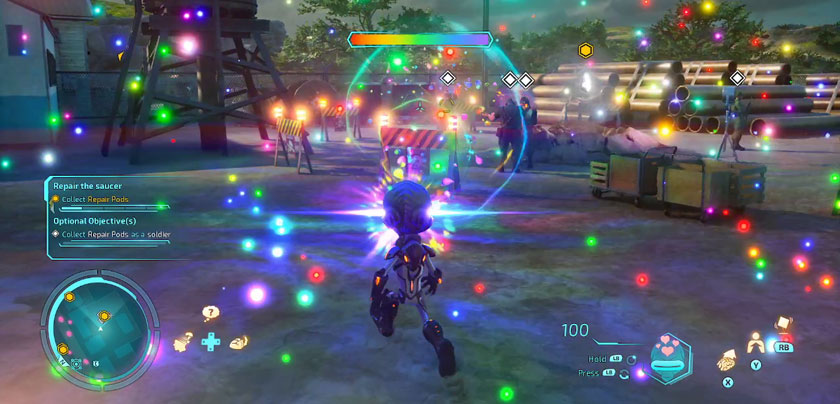
Destroy All Humans 2! Reprobed
It felt a bit strange to conclude my tour of demos with Destroy All Humans 2! Reprobed, a more AA budget project standing beside all of these smaller scale independent titles. You might even call it unfair! However, it was more unfair to THQ Nordic’s attempt to revive this old franchise with remasters, if anything. It is not only a product of a strange era, it is a product of unfocused ambitions juxtaposed against a group of independents with tighter focus, leading to tighter gameplay and polish.
Admittedly, there’s a time capsule nature to Reprobed and its open-world “sandbox”, though I’m not even sure “sandbox” is the correct term. You can’t necessarily just do what you want, especially in the early levels where the game is trying to dictate your path. You can’t just speak with a certain character, you must be wearing a specific disguise to do so. You can’t fly around your space ship yet! You have to first go across town grabbing disparate parts before you can hope to take off.
There’s an unquestionable freedom here nonetheless, where I mostly just had military and police dancing like crazy rather than directly engaging in combat. Rather than wander the streets, I used my jetpack to soar to the rooftops and take shortcuts directly to my destination. The “open-world formula” had not yet been concretely established by the likes of Ubisoft, so there was no map littered with icons of side quests and collectibles to waste my time with. Nonetheless, none of the tasks I was performing were engaging, and when the demo was still going after the one-hour mark and defeat of my target I’d been pursuing for the last forty-five minutes, I had decided enough was enough and shut it down.
Perhaps part of the problem is also the “comedic” nature of the game. Its sophomoric gags about hippies were obvious and the wrong kind of absurd. There was far too much dialogue and the missions were simplistic and generic. Outside of the cut-scenes, there wasn’t anything to really suggest humor was the goal of the game.
Which, honestly, is how I felt about the first game more than ten years ago when I played it in College on the original Xbox. I loved the premise and had been looking forward to its release, but at the end of the day I was failing to have fun. I couldn’t quite place it at the time, but it’s just an experience that provides no real challenge, fails to coax a single chuckle out of me, and can’t even provide a more relaxed atmosphere to complement the lack of challenge.
That old-fashioned, platformer-like open-world freedom is no doubt a breath of fresh air for many, however. If nothing else, Destroy All Humans 2! Reprobed does not follow the Ubisoft formula. There’s value in that in a modern setting. For me, however, I’d rather something that’s far more mechanically focused.
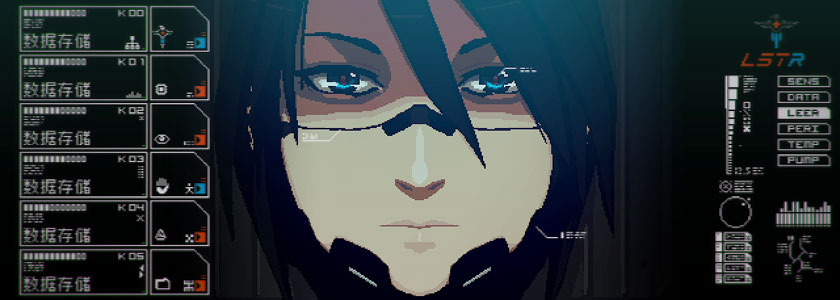
Final Thoughts
I missed out on the Steam Next Fest last year, failing to make time to play the many demos in the short window that they were available. I’m glad I managed to rectify that this year, as it not only allowed me to test out some games I was already interested in, but discover titles I otherwise might have missed and shedding others from my wishlist.
The primary highlight is Signalis, whose mood, mechanics, and atmosphere are all something that gaming has been missing for a while. That old-fashioned survival horror of the PlayStation rather than the first-person jump scare factories designed for streamer reaction highlights, or the action-horror that the Resident Evil and Dead Space franchises have evolved into. Similarly, Selaco captures a lot of that old-school “boomer shooter” feel in its pacing and mechanics, yet possesses intelligent, flanking A.I. and some modernized mechanical adjustments without sacrificing the slick speed and action of the older games. If it could get some gamepad support, I’d gladly give it another spin to see if it was just my discomfort with the keyboard and mouse that made it so difficult or if it was truly designed to be that way.
Other than those two, it’s hard to decide since the remaining games to have left an impression are all quite similar. Ghost Song, Glimmer in Mirror, Moonscars, Nine Sols, and The Tarnishing of Juxtia are all side-scrolling games that draw from either Metroid, Castlevania, Dark Souls, or all three. Nonetheless, each also felt unique in their own way, providing a different sort of experience from one another. From the more relaxed of Glimmer in Mirror to the slower paced Ghost Song, the high speed Nine Sols and the inventive Moonscars, or even the familiar yet well-executed Tarnishing of Juxtia, each game had me hooked and ready to play beyond the demo’s boundaries.
Clearly I myself have made my preferences known in terms of what sort of indie game I’m drawn to, but perhaps that’s also why I feel like we’re living in a good time for the industry. Regardless of what the big AAA studios are doing, my preferences are well-stocked and met, with this Steam Next Fest proving it. However, there were also plenty of other titles outside of my wheelhouse that I’ve been hearing positive buzz about, and even one title I Kickstarted I was unaware had a demo available: Lost Eidolons. In the end, I think Steam Next Fest proves that there’s something out there for everyone, should you be willing to seek it out.
I hope I helped you find yourself a little something, too.


